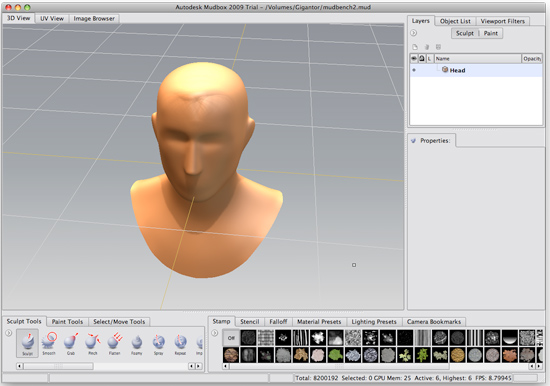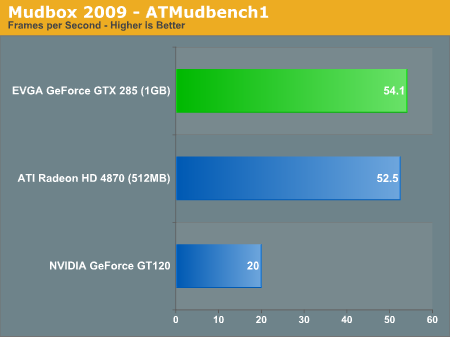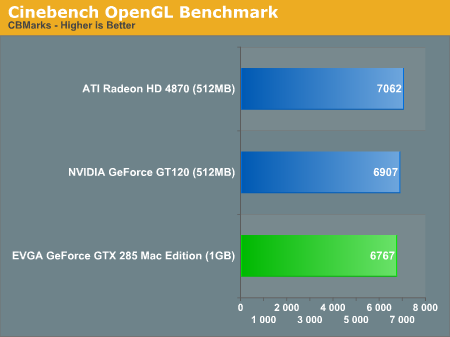EVGA's GeForce GTX 285 Mac Edition: The Best for OS X?
by Anand Lal Shimpi on July 17, 2009 7:00 PM EST- Posted in
- GPUs
OS X Apps That Need a Fast GPU
There are a few OS X apps that do benefit from a powerful GPU, but as far as I can tell the numbers are still limited. There are a number of functions that are executed on the GPU, but very few applications are actually GPU bound. Photoshop only makes minimal use of the GPU, the real benefits there come from having more video memory than having more shader processing power.
I tried using Autodesk’s Mudbox 2009 to measure GPU performance under OS X. Mudbox is a 3D modeling application that depends heavily on the GPU and includes the ability to benchmark rendering your model in real time.

Mudbox 2009
I created two models in Mudbox, one more complex than the other and measured rendering performance on the GTX 285, Radeon HD 4870 512MB and my Mac Pro’s default GeForce GT120:


The performance improvement over the GT120 is clear, but the GTX 285 wasn’t actually any faster than the Radeon HD 4870. The only advantage here is that the 285 has a larger frame buffer and could thus handle more complex models.
Even Cinebench’s antiquated OpenGL benchmark had troubles showing the GTX 285 in a positive light under OS X

This test isn’t particularly representative of anything but it does showcase some potential driver deficiencies for the GTX 285 under OS X.
OpenCL to the Rescue, CUDA Available Today
Snow Leopard will change all of this of course as it brings full OpenCL support to the table. Applications written in OpenCL will be able to execute completely on the GTX 285 and that’s where this thing will really be useful. Snow Leopard will be available in September and who knows how long it will take for good OpenCL apps to see the light of day. In other words, you may be waiting a while for your investment to pay off unless you have a high end workstation need for the GTX 285 today.

There is one other option. NVIDIA has made CUDA available for OS X, so if you’re a CUDA developer or are interested in playing around CUDA OS X apps you can put the GTX 285 to use today.










48 Comments
View All Comments
bupkus - Saturday, July 18, 2009 - link
For so very long linux never could claim itself a good platform for games. So I'm thinking, admittedly quite wishfully, that the OS X's linux roots could provide a trail for drivers in OS X to become useful in linux.What say you experts on this matter?
erple2 - Saturday, July 18, 2009 - link
OSX isn't based on Linux. It's based on a BSD flavor. I'm not sure if it's NetBSD or OpenBSD (I think NetBSD). Which is very different from Linux.Kurotetsu - Tuesday, July 21, 2009 - link
Well, according to Wiki (which means you should take it with some salt), it was both:Mac OS X is based upon the Mach kernel.[8] Certain parts from FreeBSD's and NetBSD's implementation of Unix were incorporated in Nextstep, the core of Mac OS X. Nextstep was the object-oriented operating system developed by Steve Jobs' company NeXT after he left Apple in 1985.[9]
http://en.wikipedia.org/wiki/Mac_OS_X">http://en.wikipedia.org/wiki/Mac_OS_X
sprockkets - Tuesday, July 21, 2009 - link
Yes, this is true. The BSD part is just for POSIX compliance. Even though OSX is certified UNIX, Apple saying it is UNIX stable is a bit disingenuous, as the part of the kernel doing all the work is all Apple, not UNIX or BSD.8steve8 - Friday, July 17, 2009 - link
means can't connect to the LED 24" display apple makes.weird.
Natfly - Saturday, July 18, 2009 - link
I would think a standard dvi -> mini-displayport adapter would work, right?http://www.monoprice.com/products/product.asp?c_id...">http://www.monoprice.com/products/produ...2&p_...
BrianMCan - Monday, July 20, 2009 - link
no, that is to connect a DVI monitor to mini-displayport computer.to go the other way it would have DVI male, to mini-displayport female.
Demon-Xanth - Friday, July 17, 2009 - link
...the markup on those cables is the most I've seen outside of audiophile or specialty cables.
Connectors:
4x Molex 45559-0002 $0.30ea, $0.14/ea in quantities of 5000
24x Molex 44476-1111 $0.12ea, $0.05/ea in quantities of 4000
12' 18AWG stranded wire (assuming the cables are 12") $38/100 foot spool, $145 for 1000'
(prices from Mouser, distributors may be much lower)
Low quantity cost: About $8 for the pair.
Higher quantity cost: About $3 for the pair.
Admittedly, the crimp tool itself runs about $320, so given the $52 profit margin, it should take about 7 sets to end up in the black.
rpmurray - Tuesday, July 21, 2009 - link
I'd go with the higher quality pair, according to you they're $5 cheaper then the low qualityDemon-Xanth - Thursday, July 23, 2009 - link
Quantity, not quality.The parts are $8 for two if you built one set. $3 for two if you build 1000 sets.